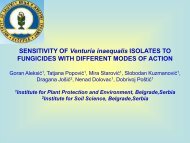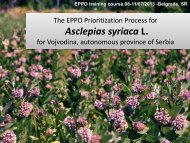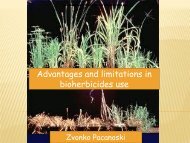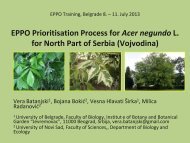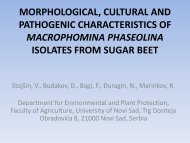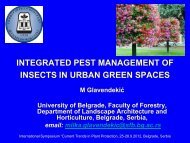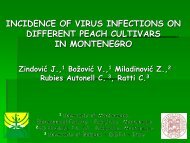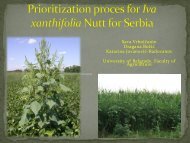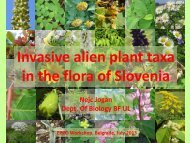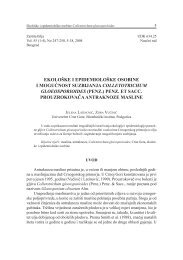QUESTIONS ON EFFECT OF CLIMATE CHANGE ON PLANT PROTECTION
questions on effect of climate change on plant protection - Izbis
questions on effect of climate change on plant protection - Izbis
Create successful ePaper yourself
Turn your PDF publications into a flip-book with our unique Google optimized e-Paper software.
<strong>QUESTI<strong>ON</strong>S</strong> <strong>ON</strong><br />
<strong>EFFECT</strong> <strong>OF</strong><br />
<strong>CLIMATE</strong> <strong>CHANGE</strong><br />
<strong>ON</strong> <strong>PLANT</strong><br />
PROTECTI<strong>ON</strong><br />
Ahmet ULUDAG<br />
Igdir University, Igdir, Turkey<br />
ahuludag@yahoo.com
GLOBAL <strong>CHANGE</strong><br />
Large-scale alteration of the<br />
natural environment<br />
All of the<br />
components considered here<br />
are anthropogenic in origin<br />
Bradley et al. 2009
Vitousek 1994
<strong>CLIMATE</strong> <strong>CHANGE</strong><br />
Long-term changes in<br />
global climate<br />
[Climate anamolies and<br />
extreme weather events]
http://www.epa.gov/climatechange/science
The European environment – state and outlook 2010<br />
http://www.eea.europa.eu/soer
Already over the last three decades, warming<br />
has had a discernible influence at the global<br />
scale on observed changes:<br />
• shifts in precipitation patterns<br />
• rising global mean sea level<br />
• the retreat of glaciers<br />
• decline in the extent of Arctic sea ice coverage<br />
• river run-off<br />
The European environment – state and outlook 2010<br />
http://www.eea.europa.eu/soer
• increases in global mean ocean temperatures<br />
• widespread melting of snow and ice sheets<br />
• increased flood risk for urban areas and<br />
ecosystems<br />
• ocean acidification<br />
• extreme climatic events including heat waves<br />
UNLESS ACTI<strong>ON</strong> IS TAKEN, CLIMATIC <strong>CHANGE</strong>S<br />
ARE EXPECTED TO LEAD TO C<strong>ON</strong>SIDERABLE<br />
ADVERSE IMPACTS<br />
The European environment – state and outlook 2010<br />
http://www.eea.europa.eu/soer
Intensive farming systems in western<br />
Europe generally have a low sensitivity to<br />
climate change, and farmers are well<br />
resourced and equipped to cope with<br />
changes. However, the agriculture sector<br />
in southern European countries may be<br />
among the most vulnerable to the direct<br />
and indirect impacts of projected climate<br />
change.<br />
EEA, 2005
Copenhagen 14 August 2010<br />
Borrowed from Georgi
The European environment – state and outlook 2010<br />
http://www.eea.europa.eu/soer
Gritti 2006
Grenz and Sauerborn, 2006
Hellmann et al., 2008
• Changes in seasonal events, flowering dates and<br />
agricultural growing seasons are observed and<br />
projected.<br />
• Phenology shifts have also increased the length of the<br />
growing season of several agricultural crops in<br />
northern latitudes over recent decades, favoring the<br />
introduction of new species that were not previously<br />
suitable<br />
• There has been a shortening of the growing season at<br />
southern latitudes<br />
• Such changes in the cycles of agricultural crops are<br />
projected to continue — potentially severely<br />
impacting agricultural practices<br />
The European environment – state and outlook 2010<br />
http://www.eea.europa.eu/soer
Space<br />
Other<br />
Trophic<br />
Levels<br />
Ecosystem<br />
Community<br />
Individual<br />
Organism<br />
Organ<br />
Gene<br />
Expression<br />
Cellular/<br />
Organismal<br />
Time<br />
Ziska and Dukes 2011
Elevated CO 2<br />
Elevated Temperature<br />
C3<br />
c4
Experimental studies and models<br />
suggest that invasive plants often<br />
respond unpredictably to multiple<br />
components of global change acting<br />
in concert.<br />
Such variability adds uncertainty to<br />
existing risk assessments and other<br />
predictive tools.
“WHAT”<br />
to understand flora and fauna changes<br />
and farming practice changes<br />
“HOW”<br />
could help us understanding magnitude<br />
and shape of problem<br />
“WHY”<br />
could give the main cause
Present CO 2 of ~380 µatm Past CO 2<br />
of ~290 µatm<br />
Future CO 2 of ~700 µatm<br />
Present CO 2 of ~380 µatm<br />
Borrowed from Ziska
Why such a strong response?<br />
285-380 µatm.<br />
Many noxious species reproduce vegetatively,<br />
from below-ground structures. Plants with large<br />
below-ground sinks show a strong response to CO 2 .<br />
Borrowed from Ziska
CO 2 affects herbicide efficacy in Canada thistle.<br />
Ambient CO 2<br />
Future CO 2<br />
Borrowed from Ziska
∙ Do we know what climate change is and<br />
how the climate will be in our region?<br />
∙ What will be the crop pattern?<br />
∙ Will cropping practices change?<br />
∙ How crop physiology will change?<br />
∙ Will introduction of alien species<br />
increase?<br />
∙ Will main pests change?<br />
∙ Will pests be more aggressive?<br />
∙ Will life cycles of pests change?<br />
∙ Will control methods change?<br />
∙ Will effectiveness of applications change?<br />
∙ What will happen with biological control<br />
agents?



